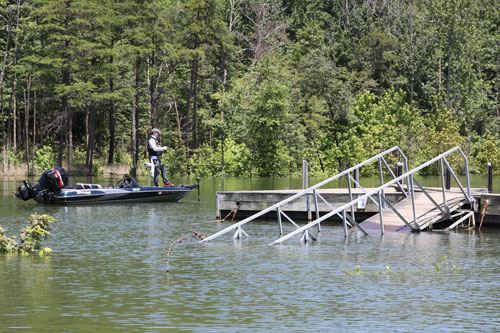BY Kevin Kelly
Anglers become conditioned to expect high water on lakes in spring and stable conditions in summer before the fall drawdowns to winter pool.
After an unusually wet spring, this summer has been anything but predictable in Kentucky. High and falling water have added a degree of difficulty at a time when fishing can be challenging under normal conditions.

Lake levels have fluctuated wildly as parts of the state picked up 6, 8, and even 10 or more inches of rain over the past month. A change from widespread heavy rains to a more typical pattern of scattered afternoon showers has allowed many lakes to inch back closer to their prescribed summer elevations.
“We haven’t had good, steady weather for a while,” said Jeremy Shiflet, assistant northwestern fisheries district biologist for the Kentucky Department of Fish and Wildlife Resources. “If we can get a steady weather pattern for just a couple of weeks things should pick up quite a bit.”
A good place to get a handle on what your lake is doing before you head out the door is the U.S. Army Corps of Engineers’ website for that district. The Louisville, Nashville and Huntington Corps’ districts provide up-to-date water information for many lakes in Kentucky.
“See what the water’s been doing,” said Geoff Roberts, a conservation educator with Kentucky Fish and Wildlife and an avid bass angler. “See if it’s coming up. See if it’s stable. See if it’s falling. That’s going to determine where the fish are positioned.”
Rising water that floods new habitat draws smaller baitfish shallow. Predator fish are apt to follow and may remain somewhat shallow if the lake stabilizes before falling.
Damp rings around tree trunks are a giveaway that water is being pulled quickly through the dam. Treat this as a sign that fish are likely to be retreating to deeper water.
“A lot of times during that hard drawdown either now or in the fall, we catch a lot of fish in our sampling nets because they’re moving,” Shiflet said. “Especially the mobile species – crappie, hybrids, white bass, walleye – they’re all on the move. The water usually gets dirty and turbid, so it’s hard for them to sight-feed. It takes them a little longer to really get cranking.”
If largemouth bass are what you’re after, resist the urge to pound the shoreline when the water is up and falling. Consider casting to the last row of visible vegetation or structure and note the contour of the bank.
“If you fish a flatter bank, then when the water comes up, that gives bass tons of areas to go,” Roberts said. “But if you fish a steeper bank, even falling water doesn’t affect those fish very much because the bank is straight up and down.
“I find it easier to fish those types of banks when the water is up and especially if it’s falling because those fish don’t get nearly as uncomfortable with falling water as the fish that have moved up on the shallow bank.”
A power or finesse technique can be effective for bass in falling water conditions.
A finesse technique employing lighter line and smaller jigs or soft plastic lures draws strikes from lethargic fish when fished slowly. Power techniques use faster presentations with larger lures such as crankbaits, jerkbaits, spinnerbaits, topwaters and heavier jigs to trigger reaction bites.
“Some anglers say they really want to finesse them and target spots that they think are holding fish and go with a really small bait presentation,” said Chad Miles, an avid angler who is the executive director of the Kentucky Fish and Wildlife Foundation. “Some people will say, no, you need to power fish them because the fish don’t want to move that much. They want to hit something and eat something big and be done with it for a while. Both options work depending on the day.”
Many anglers don’t have the luxury of being able to drop everything and fish when the weather and lake reports look favorable. They fish when they can.
An opportunity arose last week for Steve Reynolds to fish on Cave Run Lake near Morehead. The conditions looked and felt right in person even if a fishing report from the day before tempered expectations.
Heavy rains had pushed the lake’s elevation to more than 10 feet above summer pool – high enough to close some boat ramps – and the Corps had started pulling water through the dam.
Even so, within two hours of launching from Alfrey Boat Ramp at sunrise, the Versailles resident hooked and lost two muskellunge on a crankbait in about 10 feet of water before landing a 45-inch trophy.
It was Reynolds’ first encounter with a muskie and the catch qualified him for a Master Angler Award from Kentucky Fish and Wildlife. He successfully released the fish and now owns a memory from a trip when the conditions might not have been ideal but the opportunity to just get out and fish presented itself.
Author Kevin Kelly is a staff writer for Kentucky Afield magazine, the official publication of the Kentucky Department of Fish and Wildlife Resources. Get the latest from Kelly and the entire Kentucky Afield staff by following them on Twitter: @kyafield.


Be the first to comment